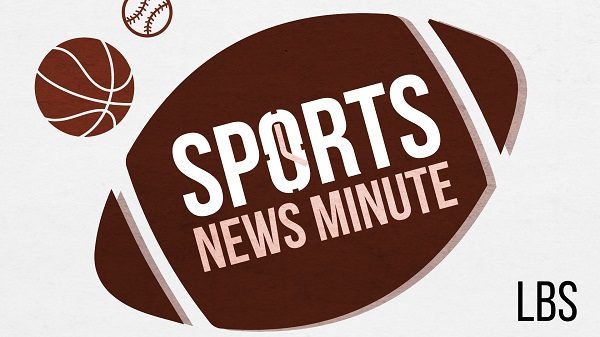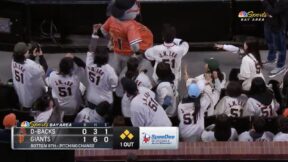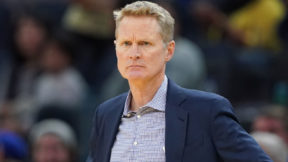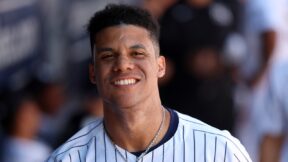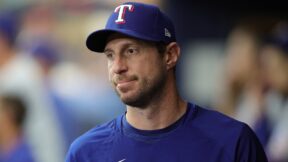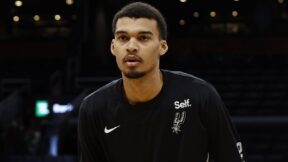Fred Lynn Would Have Considered Steroids for Recovery, Injury Prevention
 LBS spoke with former nine-time All-Star center fielder Fred Lynn. Lynn is working with the SUBWAY Baseball DeSIGNS tour, which is a traveling display of baseballs designed by kids and autographed by celebrities. The balls, which you can see here, will be auctioned off in late August with all proceeds benefiting the Little League Urban Initiative.
LBS spoke with former nine-time All-Star center fielder Fred Lynn. Lynn is working with the SUBWAY Baseball DeSIGNS tour, which is a traveling display of baseballs designed by kids and autographed by celebrities. The balls, which you can see here, will be auctioned off in late August with all proceeds benefiting the Little League Urban Initiative.
We talked with Lynn about the All-Star Game, what factors have led to baseball becoming a pitcher’s game again, and whether he would have considered using steroids as a player. We also asked him if he ever wondered what his career would have been like had he signed with the Yankees out of high school instead of attending college and getting drafted by the rival Red Sox. He also told us that the All-Star Game being played for home field advantage is gimmicky. Our interview follows.
LBS: Personally, you had a lot of success playing in All-Star games. You’re facing some of the finest pitchers in baseball in these All-Star games. How were you able to do it?
Lynn: All-Star games are usually played sometimes early in July. I was always a good hitter in June and most of the time that followed up into the All-Star Game. When you play in those games, my focus was extremely high. You’re facing Hall of Fame pitchers, and you know it at the time — you want to do really well. I enjoyed playing on that stage against the best players on the planet. Fortunately for me, I did pretty well on that stage.
LBS: There are some hitters who kind of make their living hitting off bottom-of-the-rotation guys. Is there something to be said about hitters who hit equally as well against the top guys?
Lynn: Yeah, the bottom-feeders. When I broke in, there was still four-man rotations, so we used to look at the stats to see what guys’ ERAs and strikeouts-to-walk ratios were. In those days, nobody had ERAs in the fours — not the starters anyway. If someone had an ERA in the fours, you were licking your chops.
Now with the advent of the five-man rotation, you get to the four or five guys in the rotation and you have to make your hay. Let’s face it, you’re not going to get that many hits off a [Justin] Verlander or a Jon Lester or a [CC] Sabathia. You’re going to get your share and every once in a while you’re going to catch them on a bad day, but traditionally hitters feast on middle relief and the bottom of the rotation.
In my era, you wanted to get the starter out of there to get to the middle relief because that usually was the weakness of the ball club.
LBS: We’ve gone to five-man rotations so it’s kind of watered down somewhat, but you look at the Phillies and they’ve put together one of the best rotations we’ve seen. Historically, where do you think this Phillies rotation ranks?
Lynn: The benchmark was always Baltimore because they had four 20-game winners in the early-70s and I faced a lot of those guys. It was tough sledding — you go in there and if you score three runs in a game you’re saying ‘woohoo!’ It was just tough hitting. This staff is going to be in the top five probably all time. 100 wins is probably within their reach, and these guys are probably going to have anywhere between 15 and 22 wins apiece.
LBS: Scoring has been down in baseball this year. Last year we had all kinds of no-hitters and even some perfect games. What do you think are some of the biggest reasons that is the case?
Lynn: That’s a really good question and I don’t know that I have a great answer for you because I’m not on the field. I really don’t know how hard these guys are throwing. I remember when the radar guns first came out, I don’t know if it was in the late 70s, and two companies had them. One gave a little higher reading than the other. I think the league adopted the higher speed of the two.
When you see guys throwing 97 and there’s a bunch of them, I don’t know that that’s really 97. That’s really hard, it really is. There were just a handful of guys when I played who could do that. Now, there’s three or four guys on a team that do that. If that is the case and guys are bigger, stronger, and throwing harder, then that’s the reason guys are throwing more no-hitters.
LBS: Recently Curt Schilling talked about scoring being down and he thought that steroids being out of the game, and drug testing was a big reason why. Do you think that could be a big factor in the game and scoring being down?
Lynn: Let’s face it — it’s a pitcher’s game. Hitting is the toughest thing to do in any sport. If you take [away] that artificial strength that the steroid era was giving some of the players, then the pendulum swings back to the pitcher. I don’t care if you make the mound flat, it’s still tough to hit. If guys wear down and the pitchers stay strong, then he’s always going to have the advantage.
If you’re a GM you build your team with pitching and defense and hopefully you can hit too — especially if you’re in the National League that’s how you do it. In the American League you might want some more punching. Still, when it comes playoff time, the teams with the best staff wins. Look at the Giants last year — their pitching staff got hot and they mowed ’em down. Look at the Dodgers in Hershiser’s day — they got hot and they won. You get a hot pitching staff and they’re really hard to beat.
LBS: Looking at your era of baseball, do you think if steroids were available and people saw the effects they had and how much they can boost someone’s offensive game, do you think that they would have been popular?
Lynn: It’s hard to say. Popular? Everybody’s always trying to get an edge in baseball, whatever it can be. In my time pitchers would scuff the balls and do those things. There was a little bit of color of the game. Then the pharmaceutical game. It’s hard to say who would do what in what era. I know that when you’re paid to perform and there’s something out there that you think is going to help you perform better, you’re going to be tempted to do it.
LBS: Do you think it’s something you personally would have considered?
Lynn: If it would have kept me on the field, yeah I would have considered it to be honest with you. My problem was getting injured. If one of these so-called benefits would be if you get an injury you come back faster, or you stay stronger you don’t become injured, that would be something I would have to look into.
LBS: I want to ask about your career because you spent most of your time with the Red Sox. I know you were drafted originally by the Yankees. Have you ever thought about what things might have been like had you chosen to sign with the Yankees first?
Lynn: That was out of high school, and to be honest with you, I was a young 18 and the college experience, especially going to Southern Cal, was invaluable to me. It made me who I am and it made me the kind of player that could come into the big leagues and do the things that I did right away [ed. note: Lynn won the MVP in 1975, his rookie season]. If I would have signed out of high school, I don’t know that I would have had that foundation going to the minor leagues at a young age. I really think I would not have been the same guy.
I actually played for a semi-pro team when I was 16, 17 years old that was sponsored by the Yankees, so they knew about me for a long time before I got to the big leagues. To see me in pinstripes? I hope this doesn’t go to Boston, it would be something. Center field is a storied position there, but it was bad timing — I was not ready then.
LBS: Lastly, with the All-Star Game Bud Selig made it for home field advantage in the World Series. Do you agree with that, do you like it or not?
Lynn: No I don’t. It’s too gimmicky. You get guys that are on contending teams that want to win it but I still think the team that has the best record over a 162-game schedule should have home field advantage throughout the playoffs.

